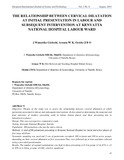| dc.contributor.author | Gichuhi, J Wanyoike | |
| dc.contributor.author | Aruasa, W K | |
| dc.date.accessioned | 2015-07-10T09:53:25Z | |
| dc.date.available | 2015-07-10T09:53:25Z | |
| dc.date.issued | 2014-08 | |
| dc.identifier.citation | W., Aruasa, W. K., & Oyieke, JBO (2014). The relationship between cervical dilatation at initial presentation in labour and subsequent intervention at Kenyatta National Hospital labour ward. eijst;3(6), pp. 47-60 | en_US |
| dc.identifier.uri | http://eijst.org.uk/images/frontImages/gallery/Vol._3_No._6/7.pdf | |
| dc.identifier.uri | http://hdl.handle.net/11295/87110 | |
| dc.description.abstract | Objectives Theaim of the study was to assess the relationship between cervical dilatation at which
parturients presented in labour and subsequent interventions. It also aimed at determming the maternal and
fetal outcomes of mothers presenting early in labour (latent phase) and those presenting late in
labour(active phase)
Design: This was a prospective comparative study
Setting: Kenyatta National Hospital, Nairobi
Population: 200 parturients who met the entry criteria
Methods: A total of200 parturients presenting to Kenyatta National Hospital in latent and active phases of
first stage of labour
Systematic sampling was used and 2 sets of parturients recruited: 100 in latent and 100 in active groups,
depending on their cervical dilatation at first assessment They were followed up in time and data collected
using a precoded questionnaire
Results: The number of vaginal examinations was high in those presenting at 0-3cm group >3 in 41% vs >3
in 10% in 4-1Ocm, p-value <0.001, which is significan | en_US |
| dc.language.iso | en | en_US |
| dc.publisher | University of Nairobi | en_US |
| dc.title | The relationship between cervical dilatation at initial presentation in labour and subsequent intervention at Kenyatta National Hospital labour ward | en_US |
| dc.type | Article | en_US |
| dc.type.material | en_US | en_US |

